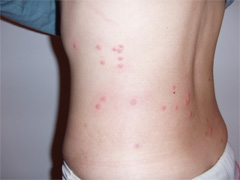
Fleas have been around for millions of years, sucking the blood of animals and humans.
Fleas live on pets, mammals, in carpets, in sofas as well as other household and farm goods.
In a typical room, 5 percent of the fleas will be found on pets, 10 percent flea cocoons in the carpets, 35 percent flea larvae and 50 percent flea eggs, again in the carpets.
The Flea life cycle is similar to the butterfly life cycle. Female Fleas lay eggs that turn in to grub-like larvae. The larvae then develop into pupae and settle inside a cocoon. They wait for a host to start their life and suck blood.
When something warm moves by the pupae, they unzip the cocoon and jump on the animal or human body. All this happens in three seconds and the flea can jump as high as four feet.
Fleas feed on blood, and a flea can live without a blood meal for 100 days. A female has to have a blood meal to lay eggs. In addition, it lays eggs within 36-48 hours of having the first blood meal. A female flea can lay 2,000 eggs in her lifetime.
Fleas are very tiny creatures, the adults average 1/8th of an inch in size. They have a flat body from side to side, with piercing mouths that help them in sucking blood.
Fleas are often confused with bed bugs, lice and ticks. However, fleas are reddish brown to black in appearance, and they are also wingless.
It is important to get rid of fleas by simple methods as these insects cause serious diseases.
Plague, Murine Typhus and Tungiasis are the diseases caused by fleas. Fleas that are lodged on rats, often carry the bacteria, Yersinia Pestis, which is the bacteria that causes Bubonic plague.
Plague is a killer disease and cannspread widely in poor countries. Murine Typhus is an infection caused by Rickettsia, Rat fleas called Xenopsilla Cheopis transmit this.
Tungiasis is caused by the Chigger flea, and they can cause serious damage to the feet as the female species burrow into the feet and breeds there.
Do fleas embed in human skin?
They sometime do, and their feeding under the skin causes severe infection and irritation. The fleas are removed by surgery.
Fleas also transmit Tularemia and tapeworms to humans as well as pets. Other than these diseases, fleas also can cause allergies to both humans and pets.
However, there is no need to worry, as there are many solutions to get rid of fleas.
You can take up the responsibility of removing fleas yourself or if the problem is severe and you are not comfortable with dealing with chemicals that may be toxic, then pest control professionals are there to help you in wiping out fleas from your house and surroundings.
Remember that adult fleas go through stages including adults, pupae, larvae and eggs. Fleas in all stages should be killed to rid your house of them completely.
Resistive pupae and larvae grow on to become adult fleas in a few weeks even though the adult fleas are killed. Fleas should be removed from all stages in
their life cycle, to protect your family and pets.

I live in florida and my dog is currently in a friend’s home loaded with fleas. I have used several treatments. Flea baths, Frontline,K9 Advantix, and nothing works. I have heard that Florida’s fleas are immune to most common brands. What is recommended here? Also, what damage might they have caused to her already?
We have bombed 4 times, put down 7Dust,…vacuumed, really everything we’ve been told to do and the fleas wont leave. Please help! We are on a fixed income and cant affird an exterminator.
Good information.Thank you,obe question: I noticed a lump on a kitten rhat looks clear but has specks pf black.Is that a flea nest?
I have an infestation of fleas in my refrigerator.I have seen (before a serious wipe-down) flea larvae andadults in my refrigerator AND MY FREEZER!!!!!Yuckkk.(Skip the next part if you have a weak stomach.) Since I have actually seen the flea larvae in my ice cream, I’m pretty sure we unknowingly ate them.Washing bedding,vacuuming, grooming animals everyday–AND they keep coming back and coming back and ……..But, nothing is changing.And how could there be fleas in the freezer?HELP!!!
e
infesta
station